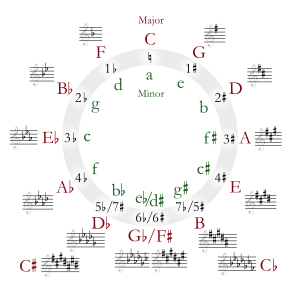C minor facts for kids
 |
||
| Relative key | E♭ major | |
|---|---|---|
| Parallel key | C major | |
| Notes in this scale | ||
| C, D, E♭, F, G, A♭, B♭, C | ||
C minor is a special musical scale that starts on the note C. A musical scale is a set of notes played in order. In music, a 'key' is a group of notes that sound good together. C minor is known for its serious or dramatic sound.
This key has three flats in its key signature. This means that when you play music in C minor, the notes E, A, and B are usually played as E-flat, A-flat, and B-flat. When musicians write C minor in jazz notation, they often use the short form Cm.
The relative major key to C minor is E-flat major. This means they share the same key signature. Its parallel major is C major, which starts on the same note but sounds brighter.
Contents
Why C Minor Sounds Dramatic
C minor has a special feeling in music. Many composers have used it to show strong emotions. It often sounds serious, powerful, or even like a heroic fight. This feeling became very popular thanks to Ludwig van Beethoven. He wrote many of his most emotional pieces in this key. Other composers then followed his style.
Famous Music in C Minor
Many well-known pieces of music are written in C minor. Here are just a few examples:
- Cello Suite No. 5 BWV 1011: VI. Gigue by Johann Sebastian Bach. Bach was a famous composer from the Baroque period.
- Great Mass in C minor (Mozart) by Wolfgang Amadeus Mozart. Mozart was a very talented composer from Austria.
- Piano Concerto No. 24 by Wolfgang Amadeus Mozart.
- Piano Concerto No. 3 by Ludwig van Beethoven. Beethoven was a German composer who lived after Mozart.
- Symphony No. 5 (Beethoven), op. 67 (1804-8). This is one of Beethoven's most famous works.
- “Choral Fantasy” in C minor, op. 80 (1808) by Ludwig van Beethoven.
- Piano Sonata No. 8 in C minor (Pathétique) by Ludwig van Beethoven. This sonata is known for its deep emotions.
- Piano Sonata No. 32 (Beethoven) by Ludwig van Beethoven.
- Symphony No. 2 (Tchaikovsky) “Little Russian” in C minor, op. 17 (1872) by Pyotr Ilyich Tchaikovsky.
- Symphony No. 8 by Anton Bruckner.
- Piano Concerto No. 2 in C minor by Sergei Rachmaninov. This is a very popular and romantic piano concerto.
- Étude Op. 10, No. 12 by Fryderyk Chopin. Chopin was a Polish composer known for his piano music.
- Prélude No. 20, Op. 28 by Fryderyk Chopin.
- Nocturne in C minor Op. 48, No.1 by Fryderyk Chopin.
- Symphony No. 4 by Dmitri Shostakovich.
- Symphony No. 8 by Dmitri Shostakovich.
- Passacaglia and Fugue in C minor by Bach.
- Symphony No. 2 by Gustav Mahler.
Scales and Keys in Music
| Diatonic Scales and Keys | |||||||||||||||||||||||||||||||||||||||||||||||||||||||
|---|---|---|---|---|---|---|---|---|---|---|---|---|---|---|---|---|---|---|---|---|---|---|---|---|---|---|---|---|---|---|---|---|---|---|---|---|---|---|---|---|---|---|---|---|---|---|---|---|---|---|---|---|---|---|---|
|
|||||||||||||||||||||||||||||||||||||||||||||||||||||||
| The table shows the number of sharps or flats in each scale. Minor scales are written in lower case. | |||||||||||||||||||||||||||||||||||||||||||||||||||||||
The Circle of fifths is a way to show how different musical keys are related to each other. It helps musicians understand key signatures and how keys can change in a piece of music.
Related pages
- List of symphonies in C minor
See also
 In Spanish: Do menor para niños
In Spanish: Do menor para niños


